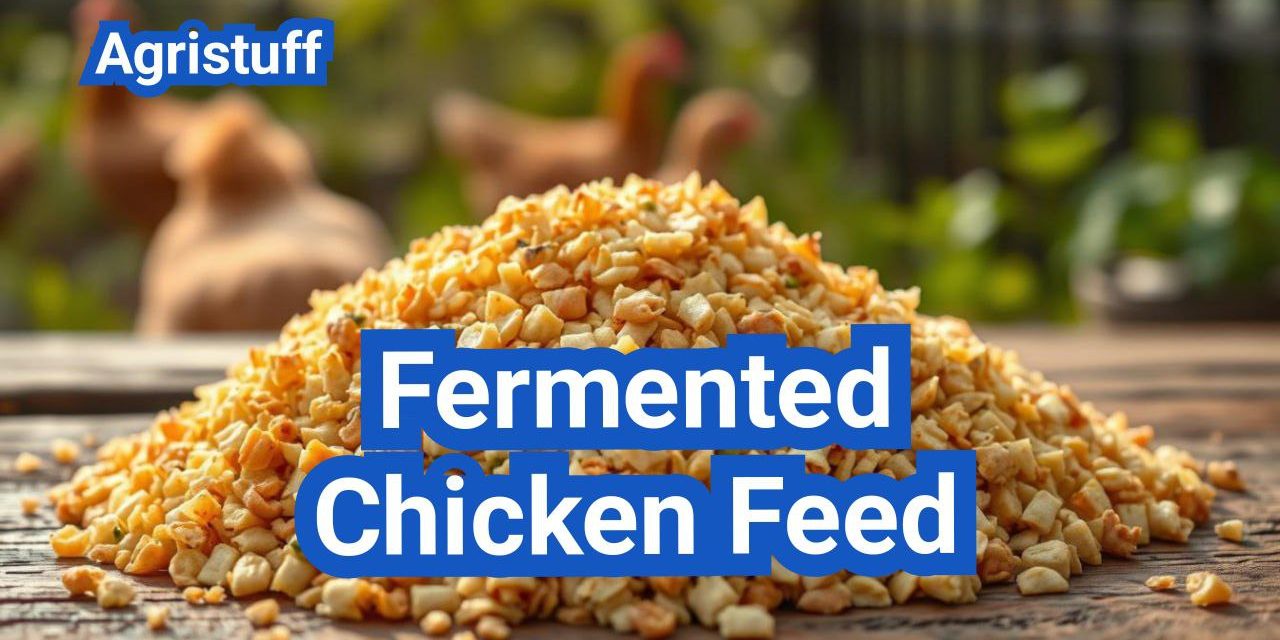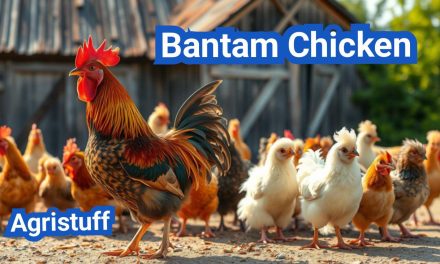Boosting the health and productivity of your backyard flock is easier than you think. One effective method is by using fermented poultry feed, a natural way to enhance nutrient availability and provide beneficial probiotics.
Lactic acid fermentation for chickens is a simple process that involves allowing regular feed to ferment in a controlled environment. This process not only enhances the nutritional value of the feed but also supports chicken gut health fermentation, leading to healthier birds and improved egg production.
Key Takeaways
- Enhances nutrient availability in chicken feed
- Provides beneficial probiotics for improved gut health
- Supports healthier birds and improved egg production
- Simple process to implement in backyard flocks
- Natural method to boost poultry health and productivity
What Is Fermented Chicken Feed and How Does It Work?
Lactic acid fermentation is a natural process that transforms regular chicken feed into a more nutritious and easily digestible form. This process involves the action of lactic acid bacteria that break down the complex compounds in the feed, making the nutrients more bioavailable to the chickens.
The Science of Lactic Acid Fermentation
Lactic acid fermentation is a metabolic process that converts sugars into lactic acid. In the context of chicken feed, this process is facilitated by lactic acid bacteria such as Lactobacillus. These beneficial bacteria thrive in anaerobic environments, breaking down the carbohydrates in the feed and producing lactic acid as a byproduct. The resulting acidic environment inhibits the growth of pathogenic bacteria, creating a more favorable gut environment for the chickens.
The science behind lactic acid fermentation is rooted in microbiology. By understanding how lactic acid bacteria interact with the feed, poultry keepers can harness the benefits of fermentation to improve chicken health. This process not only enhances the nutritional profile of the feed but also acts as a natural preservative, reducing the need for additives.
How Fermentation Transforms Regular Feed
Fermentation transforms regular chicken feed by increasing its nutritional value and making it easier to digest. The lactic acid bacteria break down complex proteins and carbohydrates, making the nutrients more accessible to the chickens. This transformation results in improved nutrient absorption, which can lead to better overall health and productivity in the flock.
Moreover, fermented feed has been shown to have a positive impact on the gut health of chickens. The probiotic properties of fermented feed promote a balanced gut microbiome, which is crucial for the chickens’ immune system and overall well-being.
The History of Fermented Feed in Poultry Raising
The use of fermented feed in poultry raising is not a new concept. Historically, farmers have used fermentation as a method to preserve feed and enhance its nutritional value. Traditional practices involved allowing feed to ferment naturally, which would often result in a more nutritious feed due to the action of beneficial bacteria.
In recent years, there has been a resurgence of interest in fermented feed due to its potential benefits for chicken health and productivity. Modern poultry keepers are rediscovering the advantages of fermentation, combining traditional techniques with scientific knowledge to create high-quality fermented feed.
The Remarkable Benefits of Fermented Chicken Feed

Fermented feed offers a natural and effective way to boost chicken health, leading to a more robust and productive flock. By incorporating fermented feed into their diet, chickens can experience a range of benefits that improve their overall well-being and productivity.
Improved Nutrient Absorption and Bioavailability
The fermentation process breaks down complex nutrients into more easily digestible forms, enhancing nutrient absorption and bioavailability. This means that chickens can extract more nutrients from their feed, leading to better overall health.
Enhanced Gut Health Through Natural Probiotics
Fermented chicken feed contains natural probiotics that promote a healthy gut microbiome. A balanced gut flora is essential for chickens’ digestive health and immune system function, reducing the risk of disease and improving overall well-being.
Strengthened Immune System and Disease Resistance
By promoting a healthy gut microbiome, fermented feed helps strengthen chickens’ immune systems, making them more resistant to disease. A robust immune system is crucial for maintaining the health and productivity of a flock.
Better Egg Quality, Size, and Production
Fermented feed can also lead to improvements in egg quality, size, and production. Hens fed with fermented feed tend to produce eggs with stronger shells, richer yolks, and more consistent laying patterns.
In conclusion, the benefits of fermented chicken feed are multifaceted, ranging from improved nutrient absorption to enhanced egg production. By incorporating fermented feed into their flock’s diet, poultry keepers can promote a healthier, more productive flock.
Choosing the Right Ingredients for Your Fermented Feed
The success of fermented chicken feed starts with selecting the right ingredients. The choice of ingredients can significantly affect the fermentation process and the nutritional quality of the feed.
Commercial Feeds That Ferment Well
Many commercial feeds can be used for fermentation, but some work better than others. Layer feeds and starter feeds are typically good choices because they contain a balanced mix of nutrients. When selecting a commercial feed for fermentation, look for products with minimal additives and avoid those with antibiotics or other medications.
Whole Grains for Optimal Fermentation
Whole grains are an excellent base for fermented feed due to their high nutrient content and ease of fermentation. Oats, barley, and wheat are popular choices among poultry keepers. These grains provide a rich source of carbohydrates, fiber, and other essential nutrients that benefit your chickens.
Scratch Grains and Mixed Feeds
Scratch grains and mixed feeds can also be fermented to add variety to your chickens’ diet. Common scratch grains include sunflower seeds, cracked corn, and millet. When fermenting mixed feeds or scratch grains, ensure that the mixture is well-balanced and provides the necessary nutrients for your flock.
Some key considerations when choosing ingredients include:
- The nutritional needs of your chickens
- The availability and cost of different grains and feeds
- The potential for allergic reactions or sensitivities
By carefully selecting the right ingredients, you can create a fermented feed that enhances the health and productivity of your flock.
Essential Equipment for Fermenting Chicken Feed

The key to effective fermented chicken feed lies in the equipment you use. To get started, you’ll need a few essential tools to ensure a successful fermentation process.
Fermentation Containers and Vessels
Choose a container that is large enough to hold the feed and water mixture, with enough space for expansion. Food-grade plastic buckets or glass jars with wide mouths are ideal for fermenting chicken feed. Ensure the container is clean and sanitized before use.
Specialized Fermented Feed Feeders
Using the right feeder can make a significant difference in your chickens’ ability to access the fermented feed. Consider using feeders specifically designed for fermented feed, as they often have features that prevent waste and mess.
Measuring Tools for Consistent Results
Accurate measurements are crucial for achieving consistent fermentation results. Use a digital scale to measure the feed and water accurately, and a thermometer to monitor the temperature.
Storage Solutions for Different Climates
Proper storage is vital to maintaining the quality of your fermented feed. Store the feed in a cool, dry place, away from direct sunlight. In hot climates, consider using refrigerated storage to slow down the fermentation process.
Step-by-Step Guide to Making Fermented Chicken Feed
Creating fermented chicken feed is a straightforward process that can significantly enhance your flock’s health and productivity. Fermenting feed is a natural way to improve nutrient absorption, boost the immune system, and increase overall poultry health.
Step 1: Selecting Your Feed Base
The first step in making fermented chicken feed is selecting a high-quality feed base. You can use either commercial chicken feed or create your own mix using whole grains and other nutritious ingredients. The key is to choose a feed that is rich in nutrients and suitable for your chickens’ life stage.
Step 2: Measuring the Perfect Feed-to-Water Ratio
To ferment chicken feed, you need to mix it with water in the right ratio. Typically, a 1:1 ratio by weight is recommended, but this can be adjusted based on the feed’s moisture content and your chickens’ preferences. Ensuring the right consistency is crucial for effective fermentation.
Key Considerations for Feed-to-Water Ratio:
- The mixture should be wet but not soupy.
- Adjust the ratio based on the feed type and climate.
- Ensure the mixture is consistent throughout.
Step 3: Adding Starter Cultures (Optional)
While not always necessary, adding a starter culture can enhance the fermentation process. Common starter cultures include whey, yogurt, or commercial probiotics. These cultures help initiate lactic acid fermentation, which is crucial for creating a healthy, probiotic-rich feed.
Step 4: Monitoring the Fermentation Process
Fermentation typically takes between 1 to 4 days, depending on factors like temperature, feed type, and desired level of sourness. It’s essential to monitor the fermentation process closely, checking for signs of healthy fermentation such as bubbles, a tangy smell, and a slightly sour taste.
Tips for Successful Fermentation:
- Keep the fermentation container clean and covered.
- Stir the mixture daily to prevent mold.
- Store the fermenting feed in a warm, draft-free area.
By following these steps, you can create a nutritious, fermented chicken feed that enhances your flock’s health and productivity. Regularly making fermented feed can become a simple yet effective part of your poultry care routine.
Basic Fermented Chicken Feed Recipe for Beginners

For those new to fermented chicken feed, starting with a simple recipe is key to success. This basic recipe will guide you through making a nutritious fermented feed that your chickens will love.
Ingredients List and Measurements
To make this fermented chicken feed, you’ll need the following ingredients:
| Ingredient | Quantity |
|---|---|
| Chicken feed | 2 cups |
| Water | 2 cups |
| Apple cider vinegar (optional) | 1-2 tablespoons |
Using Apple Cider Vinegar as a Starter
Adding apple cider vinegar can help initiate the fermentation process. It’s optional but recommended for beginners. The acidity in the vinegar helps create an environment favorable for beneficial bacteria.
Day-by-Day Fermentation Timeline
The fermentation process typically takes 2-4 days, depending on factors like temperature and desired level of fermentation. Here’s a general timeline:
- Day 1: Mix feed and water, add apple cider vinegar if using.
- Day 2-3: Monitor for bubbles and a slightly sour smell.
- Day 4: Check for desired fermentation level; it’s ready when it’s bubbly and has a tangy aroma.
Customizing the Recipe for Your Flock’s Needs
You can adjust this basic recipe based on your chickens’ preferences and nutritional needs. Consider adding other ingredients like grains or supplements to enhance the feed’s nutritional profile.
By following this simple recipe, you can provide your chickens with a healthy and nutritious fermented feed that supports their overall well-being.
Specialized Fermented Feed Recipes for Different Purposes
To maximize the benefits of fermented chicken feed, it’s crucial to develop recipes that align with the particular requirements of your flock. Different chickens have different nutritional needs; for example, laying hens require more protein, while meat birds need a growth-focused diet.
High-Protein Recipe for Laying Hens
A high-protein fermented feed recipe is ideal for laying hens, as it supports egg production. This can be achieved by adding protein-rich ingredients such as mealworms or soybean meal to the fermentation process.
Growth-Focused Recipe for Meat Birds
For meat birds, a growth-focused recipe that includes ingredients like corn and oats can promote healthy growth rates. Ensuring the right balance of nutrients is crucial for optimal development.
Balanced Recipe for Dual-Purpose Breeds
Dual-purpose breeds require a balanced diet that supports both egg laying and growth. A fermented feed recipe that combines elements of both high-protein and growth-focused recipes can be beneficial.
Seasonal Recipe Adjustments
Adjusting your fermented feed recipes seasonally can help address changing nutritional needs and environmental conditions. For instance, adding more calories during colder months can help keep your flock warm.
Feeding Schedule and Proper Amounts

To get the most out of fermented chicken feed, it’s vital to understand how much to feed your chickens and when. The amount of fermented feed required depends on several factors, including the size of your flock and the weather conditions.
Daily Feeding Guidelines by Flock Size
The quantity of fermented feed to be given to chickens varies based on the flock size. Generally, chickens consume about 1/4 to 1/3 pound of feed per day.
| Flock Size | Daily Fermented Feed Amount |
|---|---|
| 1-5 chickens | 1.25 – 1.67 pounds |
| 6-10 chickens | 2.5 – 3.33 pounds |
| 11-15 chickens | 3.75 – 5 pounds |
Transitioning from Dry to Fermented Feed
It’s essential to transition your flock gradually from dry to fermented feed to prevent digestive upset. Start by mixing a small amount of fermented feed with their regular dry feed and gradually increase the proportion over 7-10 days.
Balancing Fermented and Dry Feed Options
A balanced approach can be achieved by providing fermented feed during certain times of the day or week, while maintaining dry feed as the primary source.
Adjusting Quantities Based on Weather and Season
In colder weather, chickens may require more feed to maintain their energy levels, while in hotter weather, they may require less. Adjust the quantities accordingly to ensure optimal health.
Fermented Feed for Different Chicken Life Stages

As chickens grow through different life stages, their nutritional needs change, making it crucial to understand how fermented feed can benefit them at each stage. Fermented chicken feed is rich in nutrients and probiotics, which can enhance the health and productivity of chickens.
Is Fermented Feed Safe for Baby Chicks?
Introducing fermented feed to baby chicks requires careful consideration. While fermented feed can be beneficial, it’s essential to ensure that the fermentation process doesn’t create harmful bacteria. Chick starter feed can be fermented, but it’s crucial to monitor the fermentation process closely and introduce it gradually to the chicks’ diet.
Fermenting Starter Feed: Special Considerations
Fermenting starter feed for baby chicks involves using a feed specifically formulated for their nutritional needs. The fermentation process should be gentle to avoid creating off-flavors or harmful compounds. Using a starter culture or apple cider vinegar can help initiate fermentation.
Optimal Fermented Feed for Laying Hens
Laying hens benefit significantly from fermented feed, as it enhances egg production and quality. A fermented feed rich in calcium and other essential nutrients supports strong eggshell production. Ensuring the fermented feed is fresh and not too sour is vital for the hens’ health.
Fermented Feed Strategies for Meat Birds
For meat birds, fermented feed can promote faster growth and better health. A high-protein fermented feed can be particularly beneficial. However, it’s essential to balance the feed with other nutritional elements to ensure the birds receive a well-rounded diet.
In conclusion, fermented feed can be adapted to meet the nutritional needs of chickens at various life stages, from baby chicks to laying hens and meat birds. By understanding the specific needs at each stage and adjusting the fermented feed accordingly, flock keepers can optimize their chickens’ health and productivity.
Troubleshooting Common Fermentation Issues

Fermentation issues can arise, but knowing how to address them can help you maintain a healthy and productive flock. Fermenting chicken feed is a process that requires attention to detail, and troubleshooting is an essential skill for any flock keeper.
Addressing Unpleasant Smells
One of the most common issues with fermented feed is an unpleasant smell. While some sour smell is normal, a strong or foul odor can indicate a problem. To address this, check your feed-to-water ratio and ensure that your fermentation container is clean and not contaminated.
“A sour smell is normal, but a foul odor can be a sign of contamination or improper fermentation.”
Identifying Harmful vs. Beneficial Mold Growth
Mold growth can be a concern when fermenting chicken feed. While some mold is beneficial, other types can be harmful to your flock. To identify the type of mold, look for its color and texture. Beneficial mold is typically white or light-colored, while harmful mold can be black, green, or have a slimy texture.
| Mold Type | Color | Texture |
|---|---|---|
| Beneficial | White or light-colored | Dry, fluffy |
| Harmful | Black, green, or other dark colors | Slimy, wet, or fuzzy |
Preventing Spoilage and Contamination
To prevent spoilage and contamination, ensure that your fermentation container is clean and sanitized. Use a proper feed-to-water ratio, and monitor the fermentation process regularly. If you notice any signs of spoilage, such as a foul odor or slimy texture, discard the feed and start again.
Adjusting for Different Climate Conditions
Climate conditions can affect the fermentation process. In hot climates, fermentation can happen more quickly, while in cold climates, it may take longer. Adjust your fermentation time and temperature accordingly to ensure optimal results.
By following these troubleshooting tips, you can identify and address common fermentation issues, ensuring that your flock receives the best possible nutrition from your fermented chicken feed.
The Pros and Cons of Fermented Chicken Feed

Understanding the pros and cons of fermented chicken feed is crucial for making informed decisions about your poultry’s health. Fermented feed has gained popularity among poultry keepers due to its potential benefits, but like any feeding strategy, it comes with its own set of advantages and challenges.
The Undeniable Advantages of Fermentation
Fermented chicken feed offers several significant benefits, including improved nutrient absorption and enhanced gut health. The fermentation process breaks down complex nutrients into more easily digestible forms, making the feed more nutritious for chickens. Additionally, fermented feed contains natural probiotics that support a healthy gut microbiome, which is essential for the overall health and productivity of the flock.
Potential Drawbacks and Challenges
While fermented chicken feed has its advantages, there are also potential drawbacks to consider. One of the main challenges is the risk of contamination if the fermentation process is not managed correctly. Unpleasant odors and mold growth can occur if the feed is not properly monitored, potentially harming the chickens. It’s crucial to follow a reliable fermentation method and regularly inspect the feed to avoid these issues.
Time and Labor Considerations
Implementing a fermented feed system requires a commitment of time and labor. Preparing fermented feed involves daily tasks such as measuring ingredients, monitoring fermentation, and maintaining cleanliness to prevent contamination. For some poultry keepers, this additional workload may be a significant consideration when deciding whether to adopt fermented feeding.
Is Fermented Feed Right for Your Specific Flock?
Deciding whether fermented chicken feed is right for your flock depends on several factors, including your ability to manage the fermentation process, the size of your flock, and your specific poultry needs. It’s essential to weigh the pros and cons based on your unique situation and consider whether the benefits outweigh the challenges for your particular circumstances.
Storing and Preserving Your Fermented Chicken Feed

To keep fermented chicken feed fresh, it’s crucial to store it correctly. Proper storage maintains the feed’s nutritional value and ensures it remains safe for consumption.
Optimal Storage Conditions by Season
The storage conditions for fermented chicken feed vary by season. In warmer months, it’s essential to store the feed in a cool, dry place to prevent spoilage. During colder months, the feed can be stored in a protected area that is not prone to freezing.
| Season | Storage Conditions |
|---|---|
| Summer | Cool, dry place |
| Winter | Protected area, avoid freezing |
Maximum Shelf Life Expectations
The shelf life of fermented chicken feed depends on storage conditions. Generally, it can last up to a week when stored properly in the refrigerator.
Batch Rotation Strategies for Continuous Supply
To maintain a continuous supply, it’s advisable to rotate batches every few days. This ensures that the feed is always fresh and reduces the risk of spoilage.
Signs That Fermented Feed Has Gone Bad
Signs of spoilage include: an off smell, visible mold, or slimy texture. If you notice any of these signs, it’s best to discard the feed to avoid health risks to your chickens.
Advanced Fermentation Techniques for Experienced Flock Keepers

To maximize the potential of fermented chicken feed, advanced techniques such as continuous fermentation systems can be employed. Experienced flock keepers can benefit from these sophisticated methods to further enhance the nutritional value and health benefits of their chicken feed.
Continuous Fermentation Systems for Large Flocks
Continuous fermentation systems are particularly useful for large flocks, allowing for a consistent supply of fermented feed. This method involves setting up a fermentation vessel with a continuous flow of feed and water, ensuring a steady production of lactic acid and beneficial probiotics.
For instance, a large flock keeper can set up a multi-vessel system where one vessel is always in the fermentation phase while another is being prepared or is ready for use. This ensures a constant supply of fermented feed.
Using Molasses and Other Fermentation Enhancers
Molasses is a popular fermentation enhancer due to its rich nutrient content and ability to promote beneficial microbial growth. Adding a small amount of molasses to the fermentation mixture can accelerate the fermentation process and improve the nutritional profile of the feed.
“The use of molasses in fermentation not only enhances the nutrient content but also supports the growth of beneficial microbes.” – Poultry Nutrition Expert
Fermenting in Challenging Winter Conditions
Fermenting chicken feed during winter can be challenging due to lower temperatures. However, by using insulated fermentation vessels or maintaining a warm environment, flock keepers can continue to produce high-quality fermented feed year-round.
| Winter Fermentation Tips | Description |
|---|---|
| Use Insulated Vessels | Keep fermentation vessels in a warm or insulated area to maintain optimal fermentation temperatures. |
| Monitor Temperature | Regularly check the temperature of the fermentation mixture to ensure it remains within the ideal range. |
Drying Fermented Feed for Extended Storage
Drying fermented feed is an effective way to extend its storage life. By reducing the moisture content, the growth of harmful bacteria and mold can be inhibited, allowing for longer storage periods.
By employing these advanced fermentation techniques, experienced flock keepers can significantly improve the quality and nutritional value of their chicken feed, leading to healthier and more productive flocks.
Transforming Your Flock’s Health with Fermented Feed
Fermented chicken feed has emerged as a game-changer in poultry health and productivity. By enhancing nutrient availability and promoting gut health, fermented feed offers numerous benefits for your flock.
The benefits of fermented chicken feed are multifaceted, ranging from improved nutrient absorption and bioavailability to enhanced gut health through natural probiotics. This, in turn, strengthens the immune system and disease resistance, leading to better overall health and productivity.
By adopting fermented chicken feed, you can significantly improve poultry health and productivity. Fermented chicken feed benefits include better egg quality, size, and production, making it an attractive option for backyard chicken keepers and commercial producers alike. Improving poultry health with fermented feed is a straightforward and effective way to boost your flock’s well-being.
As you’ve learned throughout this guide, incorporating fermented feed into your flock’s diet can have a transformative impact. With its numerous benefits and relatively simple implementation, fermented chicken feed is an excellent choice for anyone looking to take their poultry health to the next level.
FAQ
What is fermented chicken feed?
Fermented chicken feed is a type of feed that has been allowed to break down by microorganisms, making its nutrients more easily accessible to chickens.
Why should I ferment chicken feed?
Fermenting chicken feed can improve nutrient absorption, enhance gut health, strengthen the immune system, and lead to better egg production.
How do I make fermented chicken feed?
To make fermented chicken feed, you’ll need to mix your chosen feed with water, add a starter culture if desired, and let it ferment for several days.
What type of feed is best for fermentation?
Whole grains, scratch grains, and mixed feeds can be used for fermentation, but it’s essential to choose a feed that is suitable for your flock’s needs.
Can I ferment commercial chicken feed?
Yes, many commercial feeds can be fermented, but it’s crucial to check the ingredients and ensure they are suitable for fermentation.
How long does fermented chicken feed last?
The shelf life of fermented chicken feed depends on storage conditions, but it can typically last for several days to a week when stored properly.
Is fermented feed safe for baby chicks?
Fermented feed can be safe for baby chicks if done correctly, but it’s essential to follow proper guidelines and take necessary precautions.
How much fermented feed should I give my chickens?
The amount of fermented feed to give your chickens depends on their size, age, and production level, but a general guideline is to provide about 10-20% of their daily feed as fermented feed.
Can I use apple cider vinegar to ferment chicken feed?
Yes, apple cider vinegar can be used as a starter culture to help initiate the fermentation process.
How do I store fermented chicken feed?
Fermented chicken feed should be stored in a cool, dry place, away from direct sunlight, and in a container that allows for airflow.
What are the signs that fermented feed has gone bad?
Signs of spoiled fermented feed include a strong, unpleasant odor, visible mold, or slimy texture.
Can I ferment chicken feed in winter?
Yes, you can ferment chicken feed in winter, but you may need to take extra precautions to keep the feed from freezing.
How does fermentation affect the nutritional value of chicken feed?
Fermentation can increase the nutritional value of chicken feed by making its nutrients more bioavailable and providing beneficial probiotics.
Is fermented chicken feed suitable for laying hens?
Yes, fermented chicken feed can be beneficial for laying hens, as it can lead to improved egg production and quality.
Can I use molasses to enhance fermentation?
Yes, molasses can be used as a fermentation enhancer to promote the growth of beneficial microorganisms.
Conclusion of: Fermented Chicken Feed
What Is Fermented Chicken Feed?
Fermented Chicken Feed is regular poultry feed that has been soaked and allowed to undergo controlled lactic acid fermentation, which lowers pH, improves palatability, and supports beneficial microbes that can aid digestion and flock health. By encouraging lactic acid bacteria to dominate, Fermented Chicken Feed becomes more acidic and less hospitable to harmful microbes, making it a practical, science-backed technique for small flocks. NC State Extension overview
How Fermentation Works Inside Fermented Chicken Feed
During fermentation, bacteria convert carbohydrates in Fermented Chicken Feed into organic acids—primarily lactic acid—which drop the feed’s pH and help inhibit pathogens while potentially enhancing nutrient availability for the birds. This microbial shift is central to the safety and functional benefits associated with Fermented Chicken Feed. BMC Veterinary Research explainer
Why pH Matters in Fermented Chicken Feed
A hallmark of properly prepared Fermented Chicken Feed is a measurable pH drop into the acidic range; experienced educators commonly target around ~4.2, a level that discourages common foodborne pathogens. Understanding this pH target—and verifying it with inexpensive pH strips—helps ensure that Fermented Chicken Feed remains both effective and safe for the flock. Target pH guidance (NC State Extension)
Core Benefits of Fermented Chicken Feed
Research links Fermented Chicken Feed with improved growth performance and feed conversion, likely through better digestibility and changes in the gut environment that favor beneficial microbes. For keepers focused on health and efficiency, Fermented Chicken Feed offers a promising, evidence-based management tip to enhance performance metrics. Peer-reviewed benefits for layers (MDPI Animals)
Beyond growth, Fermented Chicken Feed is associated with improved immune function and antioxidant status, including modulation of cytokines and immune organs in controlled studies. This suggests Fermented Chicken Feed can contribute to resilience during environmental or management stressors that commonly affect backyard flocks. Immune & antioxidant effects (PMC)
A healthier gut microbiome is another repeated finding when using Fermented Chicken Feed, with studies noting higher lactic acid bacteria, lower pH, and reduced levels of undesirable compounds in the ceca—changes that align with practical observations of better manure quality and overall flock vigor. Poultry Science evidence
Safety Basics: Keeping Fermented Chicken Feed on the Safe Side
Safety hinges on acidity and cleanliness: Fermented Chicken Feed should smell pleasantly sour (not rotten), show bubbles early on, and register a low pH that discourages pathogen growth. Using clean containers, potable water, and maintaining an acidic environment are core practices to keep Fermented Chicken Feed safe. Fermentation safety fundamentals (NC State Food Safety)
The botulism concern often raised online is addressed by acidity: environments at or below pH 4.6 are broadly recognized as hostile to Clostridium botulinum, and maintaining that acidic range in Fermented Chicken Feed mitigates risk. Verifying the pH of Fermented Chicken Feed with strips gives an extra margin of safety for homestead producers. Why pH ≤ 4.6 matters (OSU Extension)
What Commercial Practice Can Teach Backyard Keepers
While Fermented Chicken Feed is widely explored in research and small flock circles, it is not universally adopted by commercial poultry operations, which can reflect scale, logistics, and consistency requirements—not necessarily lack of efficacy. This context helps backyard keepers set practical expectations for implementing Fermented Chicken Feed at a homestead scale. Extension context on adoption (Univ. of Kentucky)
Step-by-Step: How to Make Fermented Chicken Feed
Choose a non-reactive container (food-grade plastic bucket or glass jar) that you can clean easily and cover loosely to allow gases to escape; add enough feed to cover your daily ration needs since Fermented Chicken Feed is best made and fed fresh. Consistent container hygiene supports a stable fermentation each batch. Container & setup tips (NC State Extension)
Add chlorine-free water until the Fermented Chicken Feed is completely submerged by roughly 2–5 cm; stir to remove air pockets so lactic fermentation can occur in a mostly anaerobic environment. Top up water if the feed absorbs it, ensuring Fermented Chicken Feed stays submerged throughout fermentation. Water-to-feed guidance (NC State Extension)
Keep Fermented Chicken Feed at typical room temperatures; within 24–72 hours you should see bubbles and a tangy aroma as acids build. Warmer rooms usually speed the timeline, while cooler rooms slow it—use your senses and pH strips to confirm when Fermented Chicken Feed is ready. Temperature & timing basics of fermentation
Target acidity is key: aim for a pH around ~4.2 to keep Fermented Chicken Feed in a safe, microbially favorable zone, and stir once or twice daily to redistribute microbes and prevent dry pockets. If pH stalls high, extend time or “back-slop” with a ladle of an already successful Fermented Chicken Feed batch. pH target & signs of success (NC State Extension)
When ready, strain and feed only what your flock will consume in a short meal window so Fermented Chicken Feed doesn’t sit outdoors for hours; rinse the container, and immediately start the next batch using a little “starter” liquid if desired to accelerate fermentation. This rotation keeps Fermented Chicken Feed consistent day after day. Feeding rhythm & nutrition hub (NC State)
What to Ferment (and What to Avoid) in Fermented Chicken Feed
Complete rations, crumbles, or pellets are suitable bases for Fermented Chicken Feed, but maintain the same nutrient profile you would feed dry; fermentation modifies the feed’s physical and microbial qualities, not its basic formulation requirements. Avoid random kitchen scraps that can unbalance Fermented Chicken Feed and dilute essential nutrients. Balanced ration reminders (Univ. of Kentucky)
For layers, keep calcium strategy intact when using Fermented Chicken Feed—offer a separate free-choice calcium source (e.g., oyster shell) and do not rely on fermentation to compensate for imbalanced diets. Fermented Chicken Feed complements, but does not replace, correct life-stage formulations. Layer nutrition essentials (Indiana State Poultry Assoc.)
Performance & Egg Quality: What Studies Say About Fermented Chicken Feed
Controlled trials indicate Fermented Chicken Feed can improve body weight gain and feed efficiency in various production stages, often tied to changes in the intestinal microflora and organic acids that support digestion. While results vary by study design and strain, the positive direction is consistent across many trials. Review of performance impacts
For laying hens, researchers report improved feed conversion and aspects of intestinal immunity with Fermented Chicken Feed, aligning with on-farm observations of stable intake and good shell quality when the base diet remains properly formulated. As with any nutrition tool, monitor birds and adjust as needed. Layer performance & immunity (MDPI Animals)
Not all outcomes are identical across systems: palatability, specific microbes used, and raw materials can influence results with Fermented Chicken Feed. This is why gradual adoption and record-keeping are smart—track body weight, egg production, and feed use to confirm benefits in your setup. Older layer study nuances
Microbiology Insight: Why Lactic Acid Bacteria Help in Fermented Chicken Feed
Lactic acid bacteria central to Fermented Chicken Feed are known for antimicrobial properties, immune modulation, and competition against pathogens in the gut—mechanisms that plausibly connect the feed’s souring with observed flock benefits. Selecting conditions that favor these bacteria is the core of reliable Fermented Chicken Feed. LAB functions & poultry health (PMC)
Practical Troubleshooting for Fermented Chicken Feed
If there is mold on the surface, discard and sanitize; mold indicates air exposure or contamination, and Fermented Chicken Feed should be restarted with better submersion and cleanliness. Off-odors (rancid or putrid instead of pleasantly sour) also mean you should discard and reset your Fermented Chicken Feed. Recognizing safe vs. unsafe ferments
If birds hesitate, reduce meal size and feed Fermented Chicken Feed alongside a small portion of familiar dry feed for a few days. Many flocks transition quickly once texture and routine are consistent, allowing Fermented Chicken Feed to fully replace the same daily ration amount. Feeding best practices (Penn State Extension)
Cost & Sustainability Considerations with Fermented Chicken Feed
Improved feed conversion reported in research suggests Fermented Chicken Feed can reduce overall feed needed per unit of gain or eggs, which can translate to tangible cost savings for small flocks over time. This is especially relevant when inputs are costly and keepers want every scoop of Fermented Chicken Feed to count. Evidence on FCR improvements
Some studies in broilers and growers also tie Fermented Chicken Feed to healthier gut morphology and lower odorous compounds in manure, delivering potential neighbor-friendly and environmental co-benefits in addition to performance. This systems view strengthens the case for trialing Fermented Chicken Feed thoughtfully. Reduced odorous compounds & gut health
Quality Control: Using Simple Tools to Verify Fermented Chicken Feed
Keep a small notebook for batch dates, room temperature, water ratios, and pH readings to standardize your Fermented Chicken Feed routine; this makes it easier to troubleshoot and reproduce good results. Small management habits like these often separate consistent successes from inconsistent Fermented Chicken Feed outcomes. Batch records & checks (NC State Extension)
Regulatory & Food-Safety Context (For Perspective)
Although aimed at meat processors rather than backyard feed makers, U.S. regulatory guidance on fermented products underscores the central role of lactic acid and acidity for pathogen control—principles that also underlie safe Fermented Chicken Feed. For keepers, the key takeaway is simple: clean equipment and a reliably low pH. FSIS: safe & suitable ingredients (context)
Quick, Beginner-Friendly Routine for Fermented Chicken Feed
Start with one day’s ration of complete feed in a jar or bucket, cover with water, stir, and loosely cover; stir daily, and begin checking pH after 24 hours—aim for ~4.2 by 48–72 hours. Strain and feed immediately, then restart; within a week your Fermented Chicken Feed rhythm will feel second nature. Step-by-step guide (NC State Extension)
Final thought
With a clean container, simple record-keeping, and a focus on acidity, Fermented Chicken Feed becomes a repeatable practice that can improve gut health and performance in small flocks while potentially lowering costs through better feed conversion. Start small, measure pH, and let your own data confirm the benefits of Fermented Chicken Feed. Poultry nutrition hub (Penn State Extension)
Sources & References
- NC State Extension — Fermenting Poultry Feed: Simple Steps
- NC State Extension — Fermentation & Pickling (Food Safety)
- NC Cooperative Extension — Fermentation Basics
- PMC — Effects of Fermented Feed on Growth & Immunity (2020)
- Poultry Science — Fermented Feed & Performance (2023)
- MDPI Animals — Fermented Feed in Laying Hens (2021)
- Animal — Impacts on Egg Performance & Microbiota (2022)
- PMC — Lactic Acid Bacteria in Poultry (2024)
- Oklahoma State University Extension — Importance of Food pH
- University of Kentucky — Feeds & Feeding for Small-Scale Egg Production
- University of Kentucky — Maintaining a Backyard Poultry Facility
- Indiana State Poultry Association — Raising Chickens (Layer Nutrition)
- Penn State Extension — Poultry Nutrition & Feeding
- USDA FSIS — Safe & Suitable Ingredients (Context)










